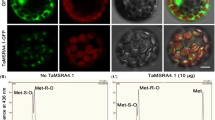Abstract
E4, which is a fruit-ripening gene that is strongly induced by ethylene, has been reported to be a member of the methionine sulfoxide reductase A (MSRA) gene. In the present study, we determined for the first time the enzymatic activity and delineated the catalytic mechanism of the E4 protein via site-directed mutagenesis. The disulfide intermolecular cross-linking, kinetics parameter, thiol content titration analysis of wild-type and mutated E4 proteins revealed that the cysteine at position 37 (Cys-37) was the key catalytic residue, and Cys-194, but not Cys-180 served as the first recycling Cys in the thioredoxin (Trx)-dependent regeneration system. In addition, the SlMSRA2 protein, which was encoded by another MSRA gene, shared high similarity with the E4 protein and was truncated at the C-terminus. The wild-type and mutated SlMSRA2 enzymes had similar activities compared to the E4 protein using DTT as a reductant, but showed extremely low activities in the Trx-dependent reduction system. Our results indicated that E4 and SlMSRA2 proteins might exhibit distinct catalytic mechanisms.



Similar content being viewed by others
Abbreviations
- Dabsyl:
-
4-(Dimethylamino)azobenzene-4′-sulfonyl chloride
- Dabsyl-Met:
-
Dabsyl-Cl labelled methionine
- Dabsyl-MetSO:
-
Dabsyl-Cl labelled methionine sulfoxide
- DTNB:
-
5,5′-Dithiobis-2-nitrobenzoic acid
- DTT:
-
Dithithreitol
- HPLC:
-
High performance liquid chromatography
- MetSO:
-
Methionine sulfoxide
- MSR:
-
Methionine sulfoxide reductase
- TCEP:
-
Tris (2-carboxyethyl) phosphine hydrochloride
- Trx:
-
Thioredoxin
References
Boschi-Muller S, Azza S, Sanglier-Cianferani S, Talfournier F, Van Dorsselear A, Branlant G (2000) J Biol Chem 275:35908–35913
Cordes S, Deikman J, Margossian LJ, Fischer RL (1989) Plant Cell 1:1025–1034
Dai C, Singh NK, Park M (2011) BMB Rep 44:805–810
Dai C, Wang M-H (2010) J Korean Soc Appl Biol Chem 53:127–132
Dai C, Wang MH (2011) BMB Rep 44:692–697
Getz EB, Xiao M, Chakrabarty T, Cooke R, Selvin PR (1999) Anal Biochem 273:73–80
Kumar RA, Koc A, Cerny RL, Gladyshev VN (2002) J Biol Chem 277:37527–37535
Lin Z, Alexander L, Hackett R, Grierson D (2008) Plant J 54:1083–1093
Lincoln JE, Cordes S, Read E, Fischer RL (1987) Proc Natl Acad Sci USA 84:2793–2797
Lowther WT, Brot N, Weissbach H, Honek JF, Matthews BW (2000) Proc Natl Acad Sci USA 97:6463–6468
Oh SK, Baek KH, Seong ES, Joung YH, Choi GJ, Park JM, Cho HS, Kim EA, Lee S, Choi D (2010) Plant Physiol 154:245–261
Poole LB, Ellis HR (2002) Methods Enzymol 348:122–136
Rouhier N, Kauffmann B, Tete-Favier F, Palladino P, Gans P, Branlant G, Jacquot JP, Boschi-Muller S (2007) J Biol Chem 282:3367–3378
Ruegg UT, Rudinger J (1977) Methods Enzymol 47:111–116
Sadanandom A, Poghosyan Z, Fairbairn DJ, Murphy DJ (2000) Plant Physiol 123:255–264
Tarrago L, Laugier E, Rey P (2009) Mol Plant 2:202–217
Tarrago L, Laugier E, Zaffagnini M, Marchand C, Le Marechal P, Rouhier N, Lemaire SD, Rey P (2009) J Biol Chem 284:18963–18971
Tarrago L, Laugier E, Zaffagnini M, Marchand CH, Le Marechal P, Lemaire SD, Rey P (2010) J Biol Chem 285:14964–14972
Taylor AB, Benglis DM Jr, Dhandayuthapani S, Hart PJ (2003) J Bacteriol 185:4119–4126
Vieira Dos Santos C, Cuine S, Rouhier N, Rey P (2005) Plant Physiol 138:909–922
Wang KL, Li H, Ecker JR (2002) Plant Cell 14(Suppl):S131–S151
Acknowledgments
This work was partially supported by a grant from Institute of Biosciences and Biotechnology at Kangwon National University. We thank Prof. Pascal Rey and Dr. Lionel Tarrago for technical assistance.
Author information
Authors and Affiliations
Corresponding author
Additional information
Changbo Dai and Woong Han have contributed equally to this work.
Electronic supplementary material
Below is the link to the electronic supplementary material.
Rights and permissions
About this article
Cite this article
Dai, C., Han, W. & Wang, MH. Two Highly Homologous Methionine Sulfoxide Reductase A from Tomato (Solanum lycopersicum), Exhibit Distinct Catalytic Properties. Protein J 31, 285–292 (2012). https://doi.org/10.1007/s10930-012-9403-z
Published:
Issue Date:
DOI: https://doi.org/10.1007/s10930-012-9403-z




